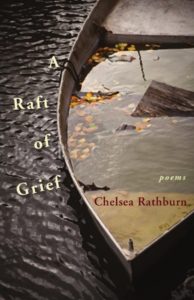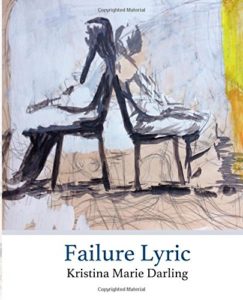Poetry and grief are no strangers; one can find expressions of grief in poetic form going back to Homer and Virgil, Beowulf and Dante. Tennyson wrote the book-length poem In Memoriam A.H.H. over the course of 17 years to express his grief at the death of his friend, Arthur Hallam.
Two recent collections by Chelsea Rathburn and Kristina Marie Darling both deal with grief, but it is a grief different from that over physical death. These poems are expressions of grief at the end of relationships.
Chelsea Rathburn even puts “grief” in her collection’s title, A Raft of Grief. And she notes the double meaning of “raft”—both as a symbol of surviving as well as signifying a large amount. The poems address the end of relationships (or perhaps the singular “relationship”) or departures, what happens immediately after, and new beginnings.
In this poem, from the “Departures” section, Rathburn compares the things that destroy relationships—lies—to vermin infesting a house.
The Lies We Told

rooting underground, away from light.
How easy to think that we were rid of them.
But sometimes, in our stillest hours, we hear
a thump in the attic or a rustling in the wall
and imagine our betrayals nesting close.
Once I found a half-chewed cord, exposed
nearly to the wire. Once you swore
you saw a tail dissolving round a corner.
For a while then, we live in our peripheries,
sure that we’ll stumble upon one any day,
creeping along the rafters, burrowing in the crawl space,
if we are only unlucky enough,
or if we stop believing the things we say
and look at the evidence of who we are,
people who seek shadows, who love the darkness.
Throughout her poems, she uses simple language to express strong emotions, heightening the reader’s understanding of the pain and the grief.
Chelsea Rathburn is the author of a previously published book, The Shifting Line. Her poems have been published in The Atlantic, Poetry and New England Review, among other journals; she’s also been published in Creative Nonfiction and Ploughshares. She’s also received a fellowship from the National Endowment for the Arts. She is currently a professor of English at Young Harris College and lives in Young Harris, Georgia.
In Failure Lyric, Kristina Marie Darling uses the prose poem form to address grief in relatively short selections. Her use of imagery is strong—how she describes various cities, sad movies as metaphors, and remembering places of meetings highlighting the relationships’ decline and end.
Here, in “Saint Wife, ” she describes the moment when the second partner recognizes that the relationship is over.
Saint Wife
At first, you didn’t quite understand. How I carried all that grief from city to city, until it turned into an enormous white halo around my head.
And the stars. The way they followed my sadness, rising and falling like an ocean. Before long, even the cities where we lived began to circle around my melancholy, each one a thread spinning through the eye of a needle.
One morning, you woke and noticed that the world around you moved differently. The freeway no longer led to the subway station. And the flower stand wasn’t where you remembered it.
You cried, but neither one of us could change it back.

One doesn’t necessarily expect the prose poem form to add beauty to the subject of grief, but that’s what Failure Lyric accomplishes.
Photo by Andrew Starwarz, Creative Commons, via Flickr. Post by Glynn Young, author of the novels Dancing Priest and A Light Shining, and Poetry at Work.
__________________________

“I require all our incoming poetry students—in the MFA I direct—to buy and read this book.”
—Jeanetta Calhoun Mish
- Longfellow’s “Paul Revere’s Ride”: Creating a National Legend - April 17, 2025
- Poets and Poems: Katie Kalisz and “Flu Season” - April 15, 2025
- Poets and Poems: Michelle Ortega and “When You Ask Me, Why Paris?” - April 10, 2025



L. L. Barkat says
I like both of these poems for their surreal qualities. They feature ordinary images, yes, but in surprising ways that feel a bit upside down to the heart (the way a relationship loss surely does).
Matthew Kreider says
Mission accomplished: I want to read more.
(And, Glynn, I’m always grateful for the opportunity to discover interesting writers here each week. I look forward to Tuesdays 🙂
Sandra Heska King says
What Matthew said.